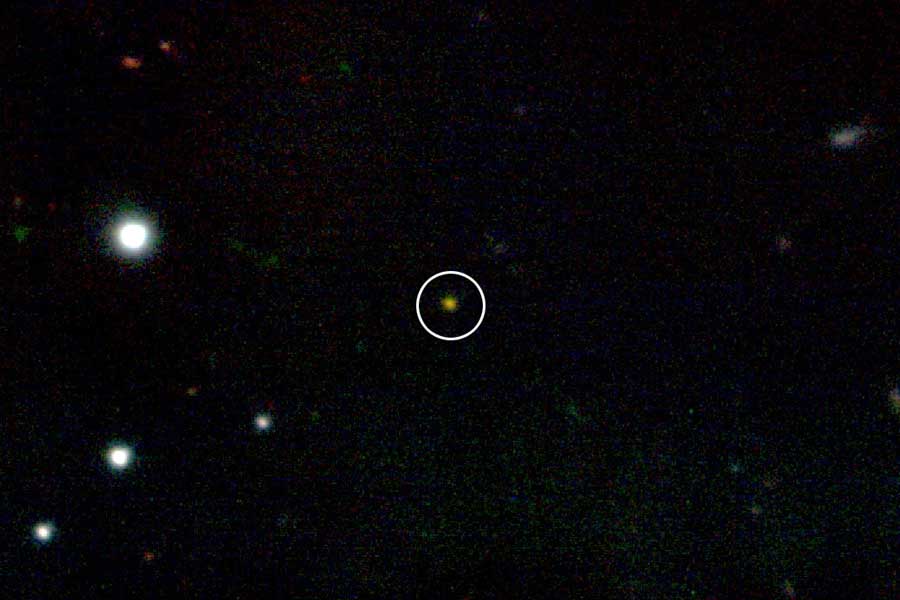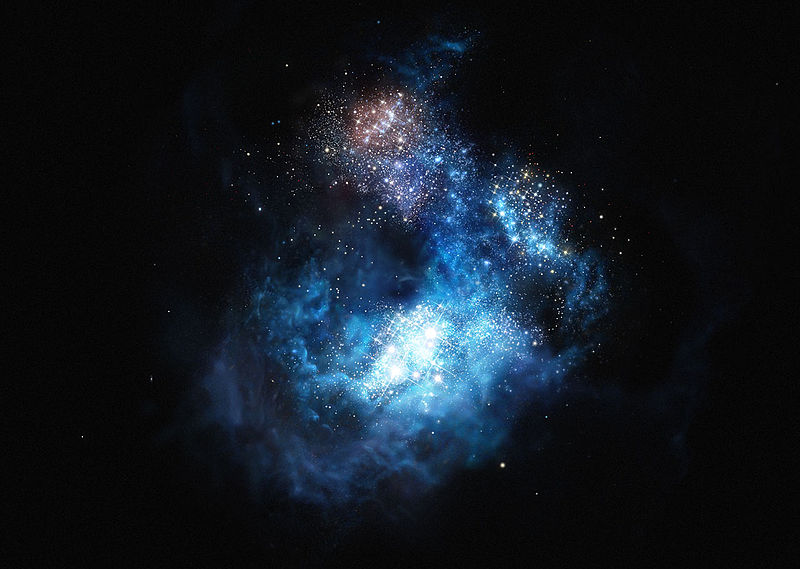Thanks to the possibility of observing the gamma-ray bursts in the optical and infrared, it is now known that they occur in very distant galaxies, so remote that some of them are listed as the most distant objects measured today. Considering the finite velocity of light, looking at far away objects is equivalent to looking back in time, to the past! Like ephemeral lighthouses in the cosmos, gamma-ray bursts allow us to probe the Universe at different times in its history and to better understand how galaxies formed over time.
Always further
These flashes are promising tools to probe the early Universe and therefore to be able to study its content and the different stages in its evolution. For example, the most distant burst identified to date, GRB090423, occurred 630 million years after the Big Bang, when the Universe was still in its prime youth.

This long burst comes from a “collapsar”: the explosion of a very massive star that collapsed on itself under the effect of its own gravity. With a mass of at least 20 to 30 times the mass of the Sun, this rare star could be among the very first generations of stars. These stars, called “population III” stars, would be very massive, luminous and made up of only a few light elements (hydrogen, helium). They would have been formed barely 400 million years after the Big Bang but it is still unclear how. Their lifespan is short: a few million years. They are supposed to be partly responsible for the formation of other elements (heavier than hydrogen and helium) detected today in the local Universe. Gamma-ray bursts can thus inform scientists about the environment in which these stars are born. They thus contribute to the understanding of stellar evolution in the primordial Universe.

Furthermore, another interesting aspect of gamma-ray bursts consists in using their signal as a background light that successively crosses different regions between the burst and the Earth. These successive environments are crossed at different distances between the burst and us and therefore at different times. The imprints left in the light of the burst could then give indications on the elemental composition of the Universe throughout its history.
Gamma-ray bursts: a laboratory of extreme physics
The overwhelming energy of the burst, the velocity of the ejected particles and the successive shocks with the surrounding environment are all elements that classify gamma-ray bursts as laboratories of extreme physical conditions which in many cases are impossible to reproduce here on Earth.
The accelerated particle energy is orders of magnitude (up to one million) beyond what the most powerful terrestrial machines like the Large Hadron Collider (LHC) can produce today. Therefore, the study of physical processes in these extreme conditions makes it possible to better understand the conditions in other classes of objects.
One example of this is the nature and energy of particles propelled in jets at relativistic velocities, which is a phenomenon also evoked to explain the origin of eruptive episodes observed in blazars (active galaxies harboring a supermassive black hole of several million solar masses).
Gamma-ray bursts are also promising sources of neutrinos and very high energy cosmic radiation.
Extremely massive stars (hundreds of solar masses), according to several scenarios, cause a particular class of bursts: extremely distant, long bursts. The study of bursts as a consequence of the explosion of stars is a tool of choice to better identify the first generation of stars (called “population III” stars) and star formation in the early epochs of the universe. Another singular aspect of gamma-ray bursts regarding short bursts is the possibility that they are sources of gravitational waves. The coalescence of two compact objects (neutron star and / or black hole) is a likely scenario to explain this short bursts. Nevertheless, the different fusion phases or the product of the coalescence are still poorly understood. A common gamma-ray burst – gravitational wave detection would allow significant advances.



